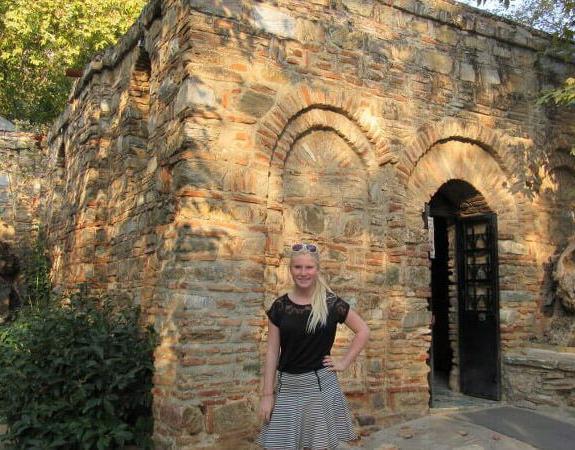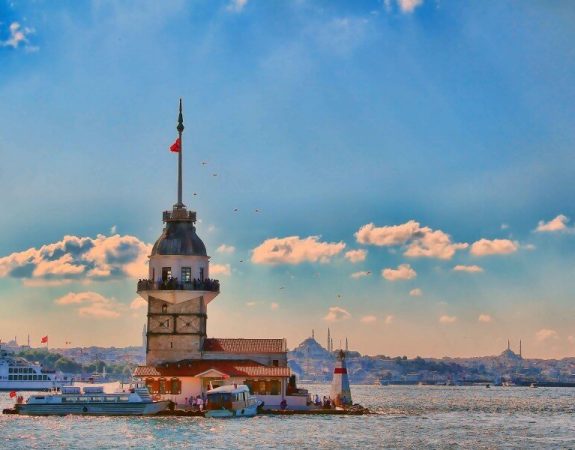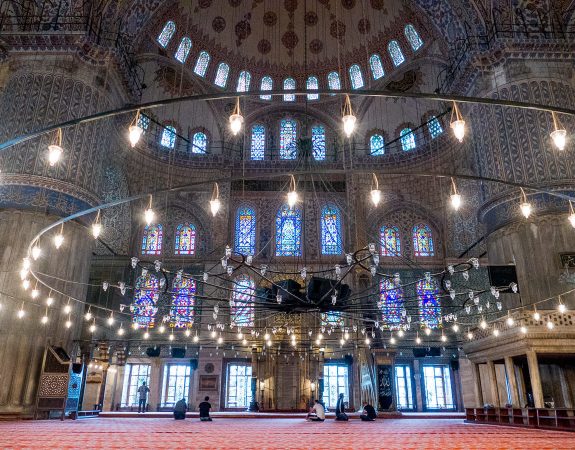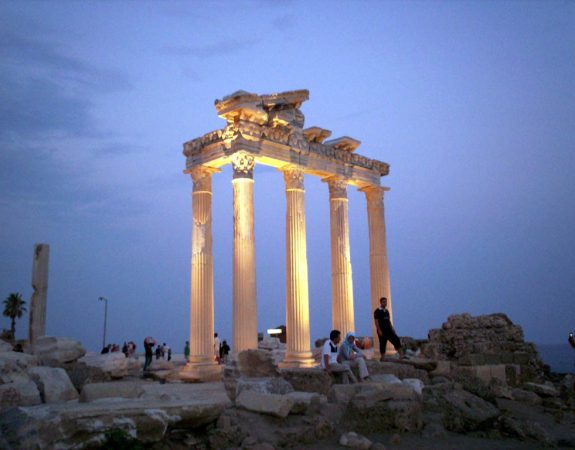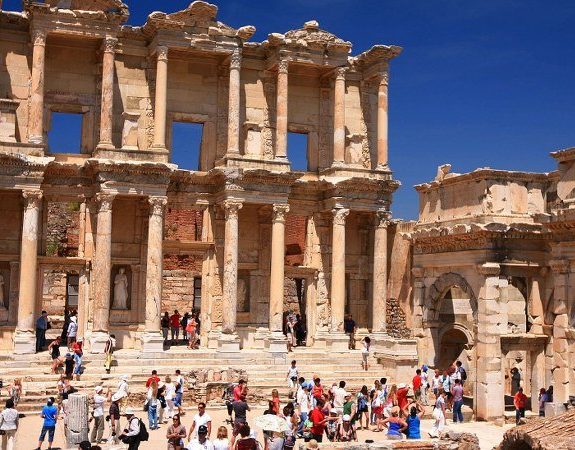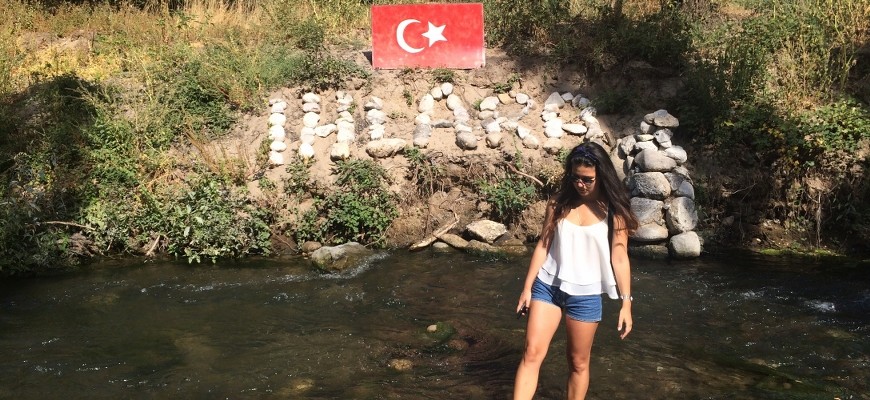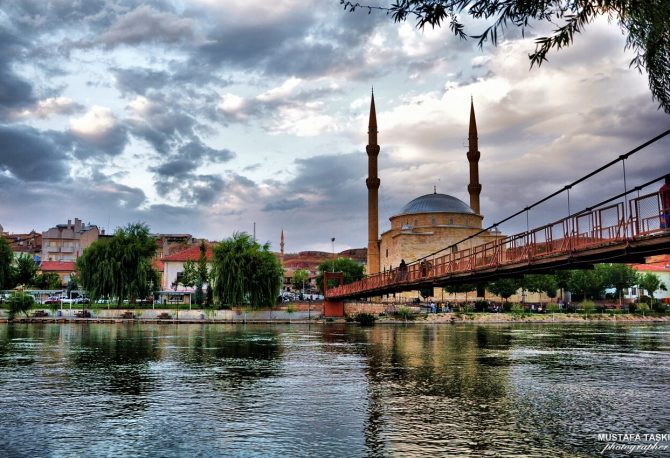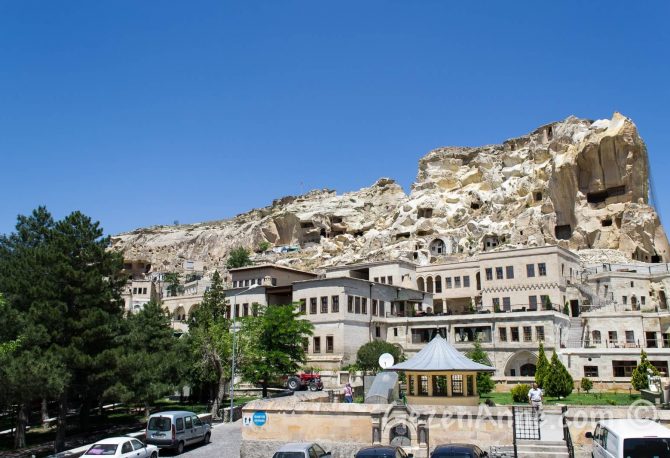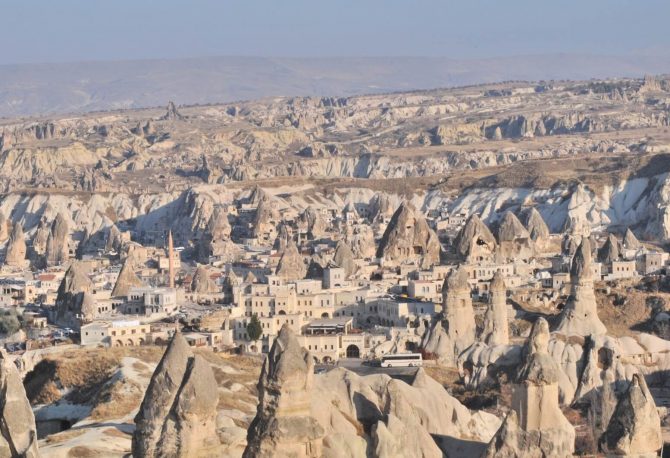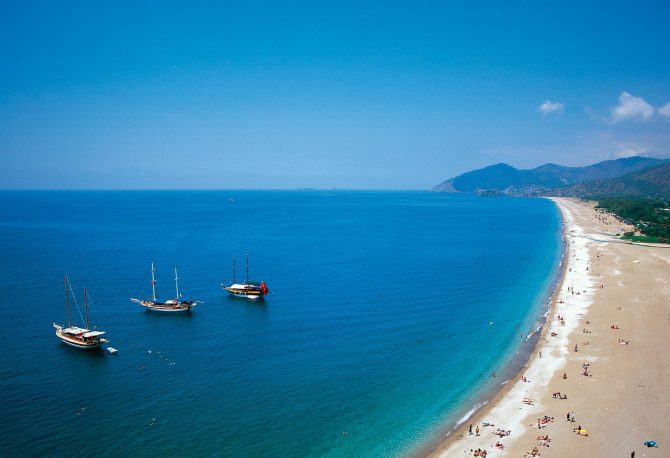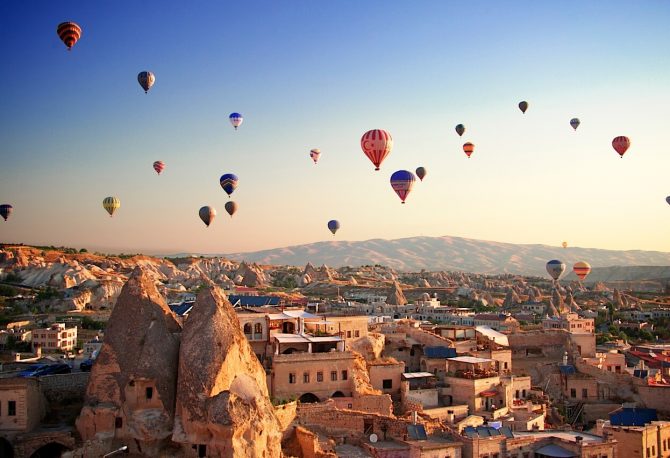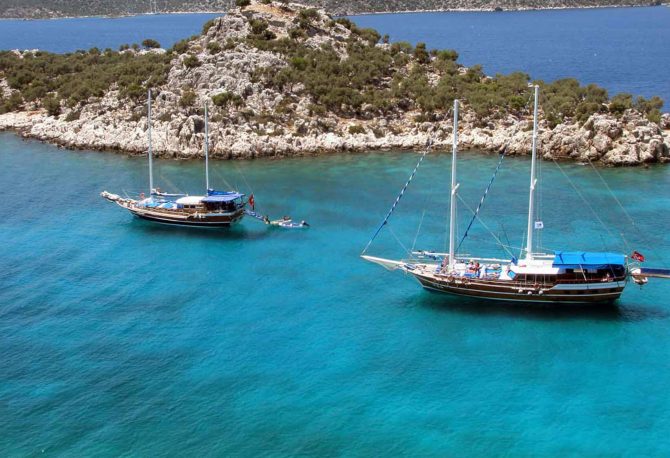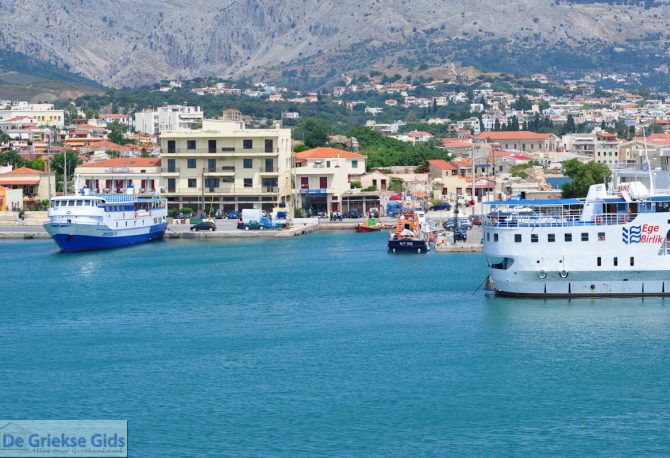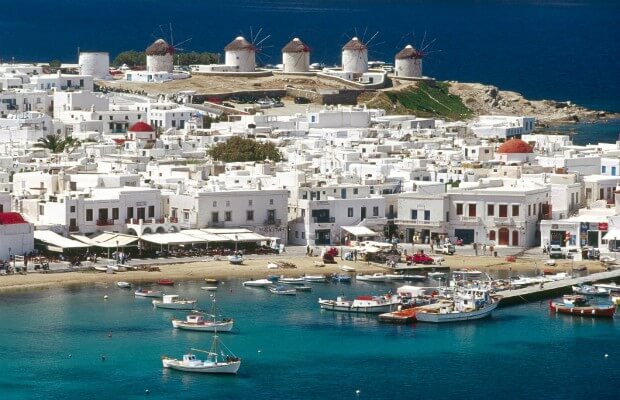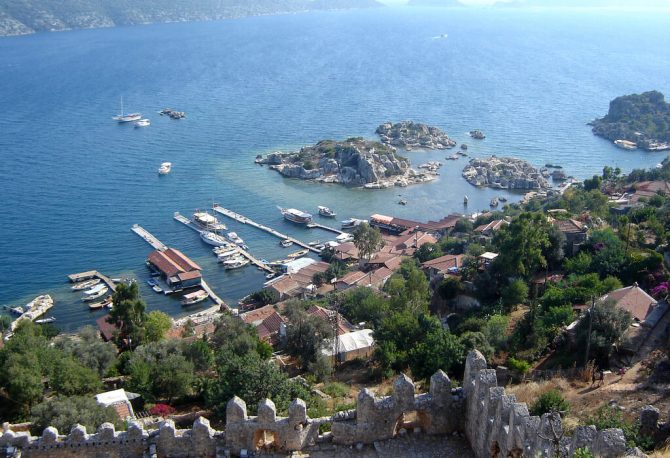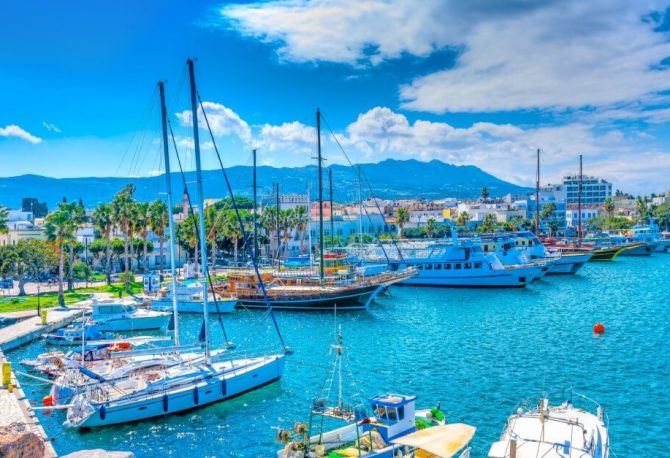The banks of the nearby wine-colored Kızılırmak, Turkey’s longest river, have been providing the potters of Avanos with red, iron-rich clay for centuries. Roughly 100 workshops crowd the area, especially in the cobblestoned Old Town. With workshop signs emblazoned with names like “Chez İsmail,” “Chez Barış,” “Chez Celebi,” and, alarmingly, “Chez Rambo,” the town clearly caters to its many foreign visitors. Watch the potters at work or try your own hand at the giant, foot- powered wheels. If clay is your thing, Avanos is close to Cappadocia’s major tourist centers as a daytrip, and vibrant and distinct enough for an extended visit.
Urgup is characterized by a conglomeration of rock formations, early Christian dwellings, and old Greek mansions. Tourists will appreciate the town’s organized information network, central otogar, and proximity to noteworthy villages and points of interest. With fewer pensions and neo-hippies than Göreme, Urgup appeals to independent travelers who tirelessly flee the commotion of tourism.
The village of Goreme is the undisputed capital of Cappadocia’s backpacker scene. Scores of tour groups operate out of Goreme, but the; city’s industry caters largely to the independent traveler. Surrounded by picturesque fairy chimneys, Göreme offers travelers no fewer than 64 pensions, mostly cave dwellings carved into the soft tufa.
Its central location makes it the best base for exploring Cappadocia, and the glorious Open Air Museum is only a short walk away. Despite the tourist traffic, Göreme has retained some of its small-town charm; apple çay offerings abound and an extended stay will probably earn you local friends. Be forewarned that visitors have been known to stay permanently in the majestic area; “once you’ve tasted Göreme’s water, you’re bound to come back,” foretells one local adage. The staggering number of foreign brides (locals say around 200) who’vc settled here suggests a different allure.
Enchanting Olimpos is a true backpacker’s town, one of the few budget spots along the Turkish Riviera. Olimpos brings travelers closer to the heavens by giving them the chance to sleep in a treehouse and make a nighttime ascent of the Chimaera, where a naturally occurring flame has burned since ancient times. Roman and Byzantine ruins are close enough to the beach that visitors can partake in nearly simultaneous cerebral and solar stimulation, but the ruins are remote enough to give a sense of forested isolation. But beware: like Homer’s Lotus-Eaters, travelers have been known to extend their stays indefinitely.
To get to Olimpos from Antalya, take a Kaş or Demre-bound bus and ask to be let off at Olimpos. From Kaş, take an Antalya-bound bus. Buses stop at a rest station on the main road. From there, dolmuş run down the 10km dirt road that leads to the treehouses (15min., every hr. 8:30am-10pm, $1.25), dropping passengers off at the pensions of their choice. From Olimpos, dolmuş return to the main road (15min., every hr. 8am-6pm, $1.25). Olimpos has no PTT, pharmacy, bank, or police station. Many pension owners accept US dollars, offer international phone calls, and arrange tours that include trekking or rafting. Postal code: 07350.
Cappadocia’s enchanting landscape remains unparalleled in history and mystery. Ten million years ago, eruptions from the volcanic Mt. Erciyes (3916m) and Mt. Hasan (3268m) covered the underlying plateaus with tufa, a soft stone made of lava, ash, and mud. Rain, wind, and flooding from the Kızılırmak River shaped the tufa into a striking landscape of cone-shaped monoliths called peribacalari (“fairy’ chimneys”), grouped in valleys and along gorge ridges. Chunks of hard basalt trapped on the surface of the prehistoric sludge protected the underlying tufa from wind erosion, thus forming bouldered caps on many of the fairy chimneys.
Cappadocia’s unique landscape has long been a hotbed of religious activity. From about 525 BC, the fire worshipping Zoroastrian Persians revered the region’s Erciyes Dag and Hasan Dag as holy mountains. Early Christians also found inspiration in Cappadocia; by the 4th century, it was a major center for Christian philosophy and civilization. Hiding from Romans, Iconoclasts, Sassanids, and Turks, these hardy Christians carved beautifully frescoed churches and colossal underground cities into the pliant tufa. Throughout Cappadocia’s staggering moonscapes, stairs, windows, and sentry holes have been carved into the rock. Many of these “troglodyte dwellings” arc still used as houses, storage rooms, or stables, while others have been converted into hotels and bars.
Visitors today are both captivated by the genius of ancient civilizations and inspired by pristine hikes through Cappadocia’s bizarre geology, which is sometimes compared to the Grand Canyon on acid. Most travelers reside in the touristy and convenient towns of Göreme and Ürgüp. The more authentic villages of Gtize- lyurt, Üçhisar, Mustafapaşa, and Ihlara may tempt you to abandon your life plans and become a local shepherd or hiking guide.
If you can only spare a day or two, it is probably easiest to stay in Göreme, visit the spectacular Open-Air Museum, and then see the highlights of Cappadocia on one of the local companies’ full-day toms.
The serpentine road from Kalkan to Kaş passes glittering inlets dotted with pebble beaches. Sandwiched between sea and mountains, cosmopolitan Kaş is refreshingly hassle-free. Its pleasant streets are lined with inexpensive, hospitable places to stay, excellent restaurants, superior artisan shops, and laid-back bars. A peninsula curves around from one side of the town’s harbor, creating a calm, rock-lined lagoon ideal for casting off for a boat trip. Kaş is unique in its character and class, allowing for chances to soak in a little Roman and Lycian history, dance to a hodge-podge of American folk, blues, rock, and Turkish pop, or simply lounge on the waterfront, cocktail in hand. Already renowned as one of the best scuba sites on the Mediterranean, Kaş is building a reputation among paragliding enthusiasts. Launches have recently opened on the same mountains whose hiking trails showcase the area’s natural beauty and local culture. Kaş hosts a national arts festival every year at the end of June, when Turks from around the country come to enjoy the professional dance, music, and art displays.
Chios (KHEE-ohs) is where the wild things were: Orion hunted every last beast down, leaving the island’s mountainsides to pine and cypress trees, and to native son, Homer. Ever since, human occupants have cultivated and exported the trees’ masticha a bittersweet, gummy resin used in a number of things from chewing gum to color TVs. Medieval Genovese and Venetian Crusaders (among them Christopher Columbus) made themselves at home here, and in 1822 Chios hosted a
failed Greek nationalist rebellion. A military base and a center of Greek shipping, (’bios only recently opened its gates to tourist infiltrators. As its striking volcanic beaches and medieval villages become more accessible, Chios flashes back to the pre-Orion days, as tourists on their way Cesme do the Wild Thing all night long.
Lush and lovely Samos accommodates a more scholarly crowd than some of its island siblings. Many see Samos as a stepping-stone to Kusadasi and the ruins of Ephesus, but this green island has been a destination in its own right for centuries. A procession of architects, sculptors, poets, philosophers, and scientists (among them Pythagoras, Epicurus, Aesop, and Aristarchus, who called the sun the center of the universe 1800 years before Copernicus) have all spent thoughtful hours on Samos’s shores.
More than just a beach town, tiny Kalkan is a surprisingly sophisticated mini metropolis that serves as a delightful base for exploring the surrounding coast. Like many Mediterranean towns, this picturesque seaside village has steep cobblestone streets speckled with pensions, varied and inviting restaurants, and small shops teeming with spices, carpets, and jewels. If Kalkan’s small, rocky harbor beach disappoints, head 3km toward Kaş for the exquisite sand of Kaputaş Beach.
Famous figures in literature and medicine have lounged on the beaches of Kos: Asclepius, god of healing; Hippocrates, father of modem medicine and the Hippocratic oath; the poet Theocritus, and his teacher Philetas. In ancient times, Kos was a major trading power with a population of 160,000 eight times that of today. It has passed under control of Italian, German, and British governments. Kos Town draws a young, loud, intoxicated crowd, while relatively unexplored rural Kos attracts more sedate travelers in search of stunning beaches and serene villages.



